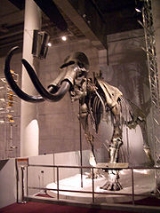
Mammuthus sungari
Encyclopedia
Mammuthus sungari, sometimes called the Songhua River Mammoth, evolved from smaller Siberian mammoths and occurred in Northern China
during the middle Pleistocene
(about 280,000 years ago). It survived until the beginning of the Late Pleistocene.
, the largest known land mammal. The original skeleton is at the Inner Mongolia
n Museum and it is based on two very large individuals found in 1980 at the Zhalainuoer Coal Mine in Hulun Buir City. These specimens indicate that it is the largest mammoth species found.
M. sungari was described by Zhou, M.Z in 1959. Wei et al. (2010), who restudied the fossils referred to M sungari, considered this species to be a junior synonym
of Mammuthus trogontherii (the steppe mammoth). The authors state that some of the fossils originally referred to M. sungari are referrable to M. trogontherii, while the others (such as the skeleton from Zhaoyuan County
, Heilongjiang
) can be referred to Mammuthus primigenius (the woolly mammoth
), according to morphological characters and measurements.
China
Chinese civilization may refer to:* China for more general discussion of the country.* Chinese culture* Greater China, the transnational community of ethnic Chinese.* History of China* Sinosphere, the area historically affected by Chinese culture...
during the middle Pleistocene
Pleistocene
The Pleistocene is the epoch from 2,588,000 to 11,700 years BP that spans the world's recent period of repeated glaciations. The name pleistocene is derived from the Greek and ....
(about 280,000 years ago). It survived until the beginning of the Late Pleistocene.
Description
The replica specimen on display at the Ibaraki Nature Museum in Ibaraki, Japan is 9.1 metres (29.9 ft) long, 5.3 metres (17.4 ft) tall, and has an estimated weight of 17 tonnes (18.7 ST)- slightly smaller than ParaceratheriumParaceratherium
Paraceratherium, also commonly known as Indricotherium or Baluchitherium , is an extinct genus of gigantic hornless rhinoceros-like mammals of the family Hyracodontidae, endemic to Eurasia and Asia during the Eocene to Oligocene 37.2—23.030 Mya, existing for approximately...
, the largest known land mammal. The original skeleton is at the Inner Mongolia
Inner Mongolia
Inner Mongolia is an autonomous region of the People's Republic of China, located in the northern region of the country. Inner Mongolia shares an international border with the countries of Mongolia and the Russian Federation...
n Museum and it is based on two very large individuals found in 1980 at the Zhalainuoer Coal Mine in Hulun Buir City. These specimens indicate that it is the largest mammoth species found.
M. sungari was described by Zhou, M.Z in 1959. Wei et al. (2010), who restudied the fossils referred to M sungari, considered this species to be a junior synonym
Synonym (taxonomy)
In scientific nomenclature, a synonym is a scientific name that is or was used for a taxon of organisms that also goes by a different scientific name. For example, Linnaeus was the first to give a scientific name to the Norway spruce, which he called Pinus abies...
of Mammuthus trogontherii (the steppe mammoth). The authors state that some of the fossils originally referred to M. sungari are referrable to M. trogontherii, while the others (such as the skeleton from Zhaoyuan County
Zhaoyuan County
Zhaoyuan County is a county under charge of Daqing City, Heilongjiang Province. It has a land area of 4,198 square kilometers and a population of 450,000. The postal code is 166500...
, Heilongjiang
Heilongjiang
For the river known in Mandarin as Heilong Jiang, see Amur River' is a province of the People's Republic of China located in the northeastern part of the country. "Heilongjiang" literally means Black Dragon River, which is the Chinese name for the Amur. The one-character abbreviation is 黑...
) can be referred to Mammuthus primigenius (the woolly mammoth
Woolly mammoth
The woolly mammoth , also called the tundra mammoth, is a species of mammoth. This animal is known from bones and frozen carcasses from northern North America and northern Eurasia with the best preserved carcasses in Siberia...
), according to morphological characters and measurements.

